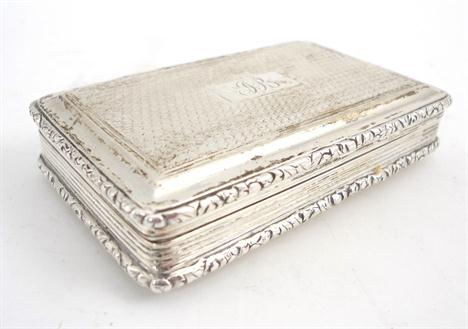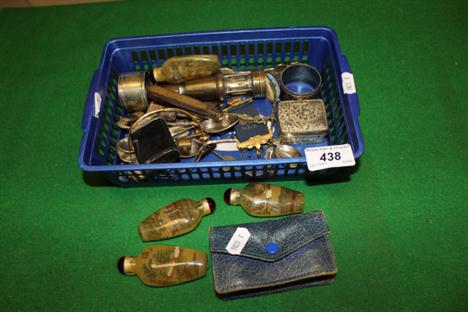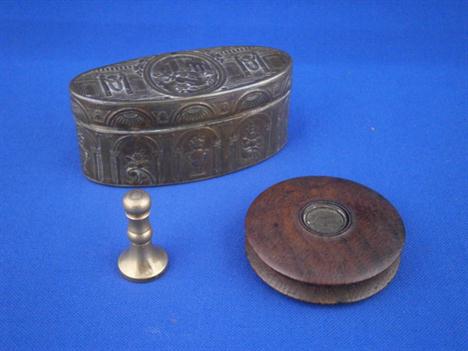We found 44471 price guide item(s) matching your search
There are 44471 lots that match your search criteria. Subscribe now to get instant access to the full price guide service.
Click here to subscribe- List
- Grid
-
44471 item(s)/page
ROBERT BURNS Carved oak case for an exciseman`s gauge - believed to have been the property of the poet. Oak rectangular box and cover, approximately 18cm x 5cm, with reeded base, naively carved to the sides with faces and hearts, an angel head to one end, the lid crudely carved in script form "Robert Burns excise man, wood from Gloume Castle, 1793". The box is contained in an early 20th century morocco leather inscribed fitted case. Provenance: With an old manuscript note (torn in two) reading "Given by Robert Burns to Sergt. Ruthven who died at Malta, 1815, was then in the possession of his brother and afterwards his brother`s son, William Ruthven, Biggar, from whom it was obtained 21/7/(18)88". Messrs Ker & Richardson have endorsed this slip certifying their belief in the veracity of this statement, 12.VII.(18)89. Accompanying this is a typescript resume of the provenance stating that it was bought by Christopher Hepper at the sale of the effects of Alderman Molyneaux Lancaster who was croupier of the Jolly Beggars Club in Manchester and "who might be expected to be a good judge of the worth of a Burns relic". Subsequently Hepper sold this box in an auction held on 27th June 1918. A page from the catalogue is included with this lot. The quite substantial price of £50 was realised for the box at that sale. * In 1788, in order to enable him to supplement his income, the friends of Burns obtained for him a much sought after appointment as an exciseman & the Commissioners of Excise specifically ordered that he be instructed "in the art of gauging and practical dry gauging casks and utensils". In 1792 whilst watching a smuggling vessel off Annan and waiting, seemingly interminably, for the arrival of Dragoons to assist, he reflected his impatience by writing the poem "The De`il`s Awa wi` the Exciseman". It could be speculated that he, perhaps in a similarly "waiting" moment, in the following year, carved himself this box - although it is much more likely that a friend carved it for him. Curiously, in 1789 Burns had received a now well documented horn snuff box with an inscription which is also crude and naive. However a comparison of the lettering shows more differences than similarities. ** Castle Gloume, now known as Castle Campbell, overlooks Dollar and the Forth valley. Burns is known to have visited the castle.
Edwardian silver trinket box, the hinged top with reeded border and with silver gilt and velvet interior, on four outswept legs, makers mark for Elkington & Co, Birmingham 1908 together with a curly horn and white metal collared snuff mule with thistle decoration and a white metal and turned wood Tibetan prayer stick (3)
A VICTORIAN SILVER AND ENAMEL SNUFF BOX the lid painted with a wood nymph bending a branch to a doe, 5 x 3.5cm, maker C P & Co possibly Cooper, Pegler & Co, Birmingham 1897 A few light scratches, the enamel with a minute graze extreme bottom left edge. The ring for suspension from a watch chain probably an early addition
[Irish interest] A William IV silver rectangular snuff box by Nathaniel Mills, Birmingham 1836, the cover engraved `Presented by The Members of The Hibernian Loan Society to Mr Andrew Halliday Dublin 1871` within a raised chased flower and scroll border, the base engine turned, the sides conformingly chased, the interior gilt, 7cm (2 3/4in) long, 82g
A George IV silver gilt rectangular snuff box by Thomas Peacock, London 1821, the cover and base engine turned with foliate chased borders and thumb piece, the cover engraved with a crest to a reserve, the inside of the cover engraved `In Memory of Lady Leighton. ob. 5 Nov. 1828`, 6.3cm (2 1/2in) long, 61g The crest of Sir William LEIGHTON (d. 1826), Lord Mayor of London for 1806-1807.
Four 19th century snuff boxes, comprising: a cowrie shell and lacquered brass example, circa 1850, 8cm (3 1/4in) long; an oval plain horn example, the cover mounted with an oval cabochon banded agate, circa 1880, 7.7cm (3in) long; a papier mâché rectangular snuff box, with an applied gold vacant reserve and chased thumb piece, painted to simulate tortoiseshell overall, 8.5cm (3 3/8in) long; and a French papier mâché circular example, with brass bands, the cover inset with an oval portrait miniature, the ground painted with flower sprays, 8cm (3 1/4in) diameter
An 18th Century Dutch brass and copper tobacco box, the hinged lid decorated with central medallion depicting a figure with stag's head and further figures looking on, inscribed "Vartwel", the base with further figural panel decoration, script and sunbursts, an 18th Century Dutch copper tobacco box, the hinged lid decorated with central figural panel flanked by further figures with scrolling foliate edge and an 18th Century brass and copper tobacco box, the hinged lid depicting Christ with the Apostles in various scenes over plain sides, the base depicting Paul and other Biblical figures and a 19th Century brass snuff box, the hinged lid with embossed decoration depicting a stag hunting scene with huntsmen and hounds, the base inscribed "A Bladen Furnace Lane" (4)
-
44471 item(s)/page

















![[Irish interest] A William IV silver rectangular snuff box by Nathaniel Mills, Birmingham 1836, the cover engraved `Presented](http://lot-images.atgmedia.com/SR/35870/2868422/97-20121113144052_468x382.jpg)


































